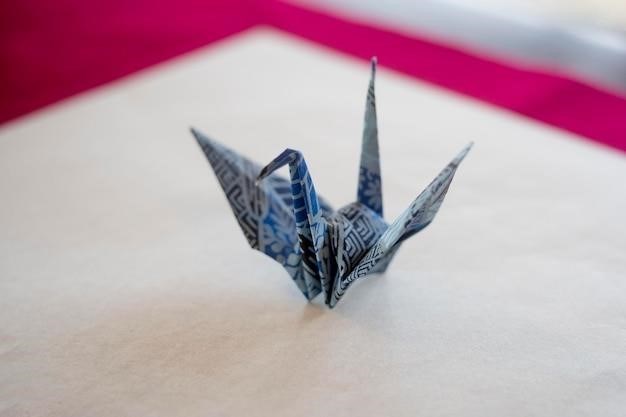Sadako and the Thousand Paper Cranes⁚ A Story of Hope and Courage
Sadako and the Thousand Paper Cranes is a poignant and inspiring story about a young girl named Sadako Sasaki who was exposed to the atomic bomb in Hiroshima, Japan. The story follows Sadako’s journey as she battles leukemia, a disease linked to radiation exposure, and her unwavering hope for recovery.
The book is based on a true story and has become a symbol of peace and resilience. It tells the tale of Sadako’s belief in a Japanese legend that folding 1,000 paper cranes grants a wish. As she folds each crane, she clings to the hope of regaining her health. Sadako’s determination and her story have resonated with people around the world, making “Sadako and the Thousand Paper Cranes” a timeless classic;
You can find free digital versions of the book in PDF format online. These versions are available for download and allow readers to access the story and its powerful message of hope and peace.
The Story of Sadako Sasaki
Sadako Sasaki was born in Hiroshima, Japan, in 1943, just two years before the devastating atomic bombing of the city. The bombing had a profound impact on Sadako’s life, as she was exposed to radiation, which later resulted in her developing leukemia. Sadako’s story begins in 1955, when she was a lively and athletic 12-year-old girl who loved to run and play. She was a happy and carefree child, unaware of the invisible threat that lurked within her.
One day, Sadako started feeling unwell. She was experiencing fatigue and dizziness, and her symptoms worsened over time. After being hospitalized, she was diagnosed with leukemia, a devastating illness that was directly linked to the radiation exposure she had suffered as a child.
As Sadako faced her illness, she learned about a Japanese legend that folding 1,000 paper cranes would grant a wish. She decided to dedicate herself to folding paper cranes, believing that if she completed the task, she would be healed and be able to return to her active life. Sadako’s story is a poignant reminder of the long-lasting effects of the atomic bomb and the strength and resilience of the human spirit in the face of adversity.
The Legend of the Thousand Paper Cranes
The legend of the thousand paper cranes, known as “Senbazuru,” is deeply rooted in Japanese culture and folklore. This ancient tradition holds that folding one thousand paper cranes brings good fortune and fulfills a wish. The crane, a symbol of peace, longevity, and good health, holds a special place in Japanese mythology.
The story of the thousand paper cranes is often linked to a tale about a young girl who, after being saved from a deadly illness, vowed to fold a thousand cranes as a gesture of gratitude. This act of dedication and perseverance resonated with people throughout the ages, solidifying the belief in the power of the thousand paper cranes.
In Sadako’s story, the legend serves as a beacon of hope. Her unwavering belief in the power of the cranes gives her strength and courage to face her illness. The act of folding each crane becomes a symbolic act of resilience and a testament to her unwavering determination to overcome her challenges.
The Impact of the Atomic Bomb on Hiroshima
The atomic bombing of Hiroshima on August 6, 1945, had a devastating and lasting impact on the city and its inhabitants. The explosion unleashed an immense wave of destruction, causing widespread devastation and casualties. The effects of radiation exposure from the bomb continued to affect the population for years to come, leading to illnesses such as leukemia, a disease that tragically claimed the life of Sadako Sasaki.
The story of Sadako and the Thousand Paper Cranes serves as a poignant reminder of the human cost of war and the long-term consequences of nuclear weapons. Sadako’s experience highlights the tragic reality that many survivors of the bombing faced, struggling with the lasting effects of radiation exposure.
The story also underscores the importance of peace and the need to work towards a world free from nuclear weapons. Sadako’s legacy continues to inspire people to advocate for peace and to remember the devastating impact of war on innocent civilians.
Sadako’s Fight Against Leukemia
Sadako’s life took a tragic turn when, at the age of 11, she was diagnosed with leukemia. This devastating illness was a direct consequence of the atomic bomb’s radiation exposure. Undeterred by the severity of her condition, Sadako clung to hope and sought solace in an ancient Japanese legend. She believed that by folding a thousand paper cranes, she could make a wish for her recovery.
With unwavering determination, Sadako began her journey to fold a thousand cranes. She spent countless hours meticulously crafting each crane, pouring her hope and resilience into every fold. Her friends and family joined her in her endeavor, folding cranes alongside her. Sadako’s story became a symbol of courage and resilience in the face of adversity.
Despite her valiant fight, Sadako succumbed to her illness at the age of 12. Her story, however, continued to inspire generations after her, reminding us of the power of hope and the enduring spirit of humanity.

The Symbolism of the Paper Cranes
The paper crane, known as “origami tsuru” in Japanese, holds profound cultural significance in Japan. It is a symbol of peace, longevity, and good fortune. The intricate folds of the crane represent the delicate balance of life and the interconnectedness of all things. The paper crane’s graceful flight symbolizes the aspiration for peace and harmony.
In “Sadako and the Thousand Paper Cranes,” the paper crane takes on a deeper significance. It becomes a symbol of hope, resilience, and the enduring human spirit. Sadako’s belief in the legend of the thousand paper cranes represents her unwavering faith in the power of wishes and the possibility of healing.
The act of folding paper cranes, as Sadako did, becomes a metaphor for the human capacity for hope and the resilience of the human spirit. It is a testament to the power of belief and the enduring desire for peace and well-being.
The Legacy of Sadako and the Thousand Paper Cranes
Sadako’s story and the enduring power of the paper crane have left an indelible mark on the world. Her legacy is one of peace, hope, and the resilience of the human spirit. Sadako’s story continues to inspire generations of children and adults worldwide.
The paper crane has become a global symbol of peace and a reminder of the devastating consequences of war. It serves as a call for peace, understanding, and the pursuit of a world free from violence and conflict.
The story of Sadako and the thousand paper cranes has been translated into numerous languages and has been adapted into various forms of media, including films, plays, and art installations. It has become a cornerstone of educational programs on peace, empathy, and the power of hope. Sadako’s story continues to inspire individuals to embrace peace and to strive for a better world.
Where to Find “Sadako and the Thousand Paper Cranes”
If you’re seeking a captivating story that transcends time and resonates with the human spirit, “Sadako and the Thousand Paper Cranes” is readily available in various formats. The book is a classic for a reason, and its poignant message continues to touch hearts and minds; You can find the book in print format at most bookstores and online retailers.
For those who prefer digital access, there are multiple online platforms where you can locate “Sadako and the Thousand Paper Cranes.” You can search for free PDFs online, accessing the story directly on your device. Additionally, several websites offer the book for purchase in digital formats, providing a convenient and accessible way to experience this powerful story.
No matter how you choose to experience “Sadako and the Thousand Paper Cranes,” the story’s enduring message of hope, courage, and the power of human resilience is sure to leave a lasting impression.
The Importance of Peace and Hope
At its core, “Sadako and the Thousand Paper Cranes” is a story about the enduring human spirit, the power of hope, and the unwavering pursuit of peace. Sadako’s story, a young girl who was a victim of the atomic bomb’s devastation, embodies the resilience of the human spirit. She embodies the hope that even in the face of immense tragedy, life can still flourish. The story underscores the importance of peace and the desire to live in a world free from the horrors of war.
Sadako’s unwavering belief in the legend of the thousand paper cranes, and her determination to fold them despite her illness, is a powerful testament to the strength of hope. The story encourages readers to embrace the idea that even in the darkest of times, hope can act as a guiding light.
The enduring message of “Sadako and the Thousand Paper Cranes” resonates with readers of all ages, reminding us that peace and hope are essential elements of a meaningful life. It encourages us to strive for a world where peace prevails and to embrace hope as a guiding force in our own lives.
The Power of Storytelling
The story of Sadako Sasaki has transcended the pages of a book and has become a powerful symbol of hope and resilience, inspiring countless people around the world. The impact of “Sadako and the Thousand Paper Cranes” lies in its ability to connect with readers on an emotional level, allowing them to engage with the story’s themes of hope, courage, and the desire for peace.
The story’s simple yet profound narrative resonates with readers of all ages, making it a powerful tool for teaching important life lessons. The story’s timeless themes of hope, courage, and the desire for peace have universal appeal, transcending cultural and generational boundaries. The story’s ability to connect with readers on a deeply personal level highlights the power of storytelling to inspire, educate, and bring people together.
The story of Sadako Sasaki, a young girl whose life was tragically cut short by the effects of the atomic bomb, serves as a powerful reminder of the devastating consequences of war. The story’s enduring popularity is a testament to the power of storytelling to inspire and educate, reminding us of the importance of peace and the resilience of the human spirit.
The Continued Relevance of Sadako’s Story
Despite being written decades ago, “Sadako and the Thousand Paper Cranes” remains deeply relevant in today’s world. The story’s themes of hope, resilience, and peace resonate with a global audience, offering a timeless message that transcends generations and cultures. Sadako’s story serves as a powerful reminder of the enduring human spirit in the face of adversity, a message that continues to inspire and uplift people around the world.
In an increasingly interconnected world, the story’s message of peace and understanding is more important than ever. Sadako’s story serves as a reminder of the devastating consequences of war and the importance of working towards a peaceful future. The story’s continued relevance is a testament to the power of storytelling to connect people across time and space, reminding us of the shared humanity that binds us all.
The story’s enduring popularity is a testament to the power of storytelling to transcend time and inspire generations. “Sadako and the Thousand Paper Cranes” continues to resonate with readers, offering a powerful reminder of the enduring human spirit and the importance of peace, hope, and resilience.
